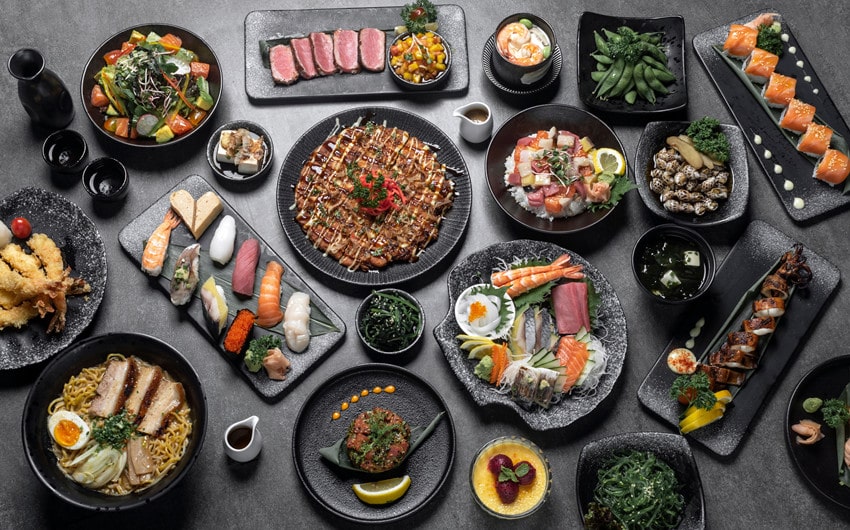No where in the world does food quite like Japan. From the artistry of sushi to the charm of street foods like takoyaki, here’s a guide to eight unforgettable Japanese meals that deserve a spot on your food itinerary.
1. Sushi: A National Icon
Sushi, with its delicate balance of flavors, has become an internationally recognized symbol of Japanese cuisine. This dish began as a way to preserve fish by fermenting it in rice. In the Edo period (1603-1868), sushi evolved into “edomae-zushi,” where fresh fish or seafood is served over vinegared rice.
In Tokyo’s bustling Tsukiji Outer Market, you’ll find casual standing sushi bars and fine dining spots alike, offering an array of fresh sushi that showcases Japan’s dedication to quality and presentation.
2. Ramen: Japan’s Soul Food
Introduced from China, ramen has become a Japanese comfort food, with distinct regional twists. Each area of Japan has its unique spin on ramen, resulting in varieties like Hakata’s creamy tonkotsu (pork bone broth) ramen and Sapporo’s hearty miso ramen, often topped with sweet corn and butter.
Tokyo Station’s “Ramen Street” is a great place to sample these different styles. Whether you’re craving a rich, savory broth or a spicy miso kick, ramen is a satisfying, warming meal at any time of day.
3. Okonomiyaki: Japanese Pancake with a Twist
Okonomiyaki, meaning “grill as you like,” originated in the Kansai region and is particularly popular in Osaka and Hiroshima. Often referred to as Japanese-style pizza, this savory pancake combines flour, eggs, shredded cabbage, and ingredients like pork belly or seafood.
In Osaka, diners can cook their own okonomiyaki at tabletop grills, creating a hands-on dining experience. Hiroshima’s version layers the ingredients rather than mixing them, and typically adds noodles for a heartier twist. It’s a versatile dish that’s as fun to make as it is to eat.
4. Tempura: Lightly Battered and Delicious
Tempura, introduced to Japan by Portuguese missionaries in the 16th century, is a simple yet refined dish. Fresh seafood or vegetables are lightly coated in batter and deep-fried to a crisp perfection.
Tokyo’s Asakusa district is known for its classic edo-style tempura, served with a light tentsuyu dipping sauce. Each bite highlights the natural flavor of the ingredients, making tempura an ideal option for those seeking a balanced yet indulgent treat.
5. Takoyaki: Osaka’s Famous Snack
Takoyaki, which originated in Osaka in the 1930s, is a popular street food snack made from round balls of dough filled with chopped octopus, green onions, and tempura scraps.
They’re cooked in special round molds, then topped with takoyaki sauce, mayonnaise, and bonito flakes that dance with the heat.
Takoyaki is especially popular at festivals, but you’ll find vendors throughout Osaka, as well as in major cities across Japan. It’s a delicious snack that captures the fun, fast-paced energy of Japanese street food culture.
6. Shabu-Shabu: Japanese Hot Pot for Sharing
Inspired by Chinese hot pot, shabu-shabu became a popular Japanese dish in the 20th century. Named for the swishing sound of ingredients in the broth, it involves dipping thinly sliced meats, tofu, and vegetables into simmering broth, followed by a dip into ponzu or sesame sauces.
Kyoto is known for its refined shabu-shabu restaurants, where high-quality wagyu beef enhances the meal. This communal dining experience is ideal for cold-weather gatherings and brings out the warmth of Japanese hospitality.
7. Unagi (Grilled Eel): A Summer Treat
Unagi, or grilled eel, has been a celebrated dish in Japan since the Edo period. Served over rice and glazed with a sweet sauce, unagi is rich in flavor and believed to boost stamina, making it a popular choice during Japan’s hot summer months.
Specialty unagi restaurants near Lake Hamana in Shizuoka are particularly famous for their high-quality eel, offering an unadon (eel rice bowl) that showcases its tender texture and smoky flavor. Unagi is an ideal choice for those looking to taste a cherished traditional Japanese delicacy.
8. Bento Boxes: Perfect for Travelers on the Move
Bento boxes, known for their artful presentation and variety, have been a staple since the Kamakura period (1185–1333). Packed with seasonal ingredients, rice, pickles, and small side dishes, bento boxes are available in convenience stores, department stores, and train stations across Japan.
Travelers with the Japan Rail Pass will enjoy sampling ekiben (station bento boxes) during train journeys, as each station’s bento reflects local culinary traditions. This makes bento not just a convenient meal but also a cultural experience that enhances any travel itinerary.
Conclusion
Exploring Japan’s food scene reveals a deep respect for seasonal ingredients, simplicity, and flavor balance. Each meal, from the delicate sushi to the bold flavors of okonomiyaki and the shared experience of shabu-shabu, adds to the joy of travel in Japan. These dishes bring together history, tradition, and local pride, making Japan’s cuisine not only delicious but also an essential part of experiencing the culture.
As you journey through different regions, trying these diverse flavors will deepen your appreciation for Japan’s culinary heritage and make your travels even more memorable.







